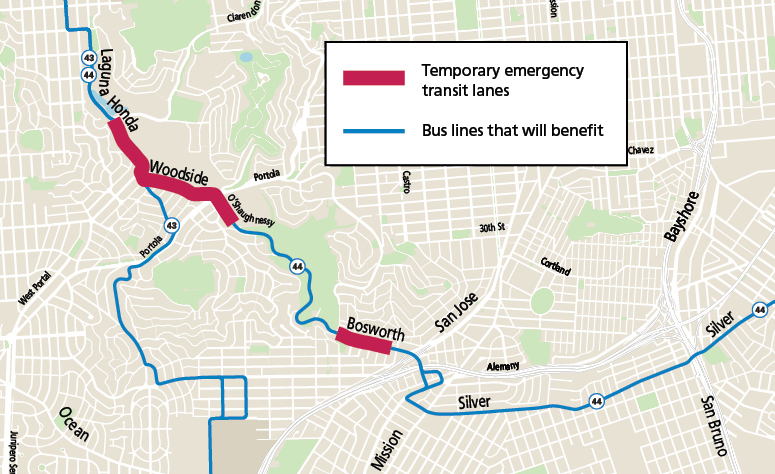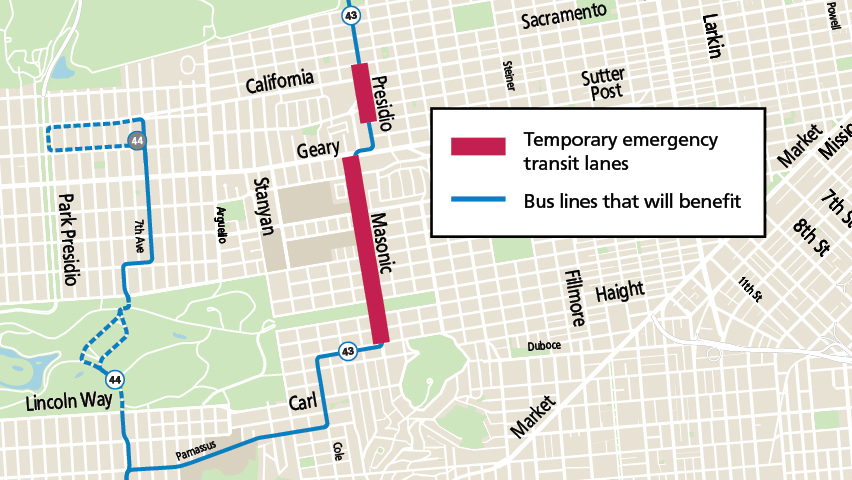Project Introduction
As traffic congestion returns, the SFMTA is working to protect San Franciscans who continue to rely on Muni to get to work and essential appointments during this pandemic. If just a fraction of the people riding transit before the crisis begin driving alone, traffic congestion will be so severe that it could paralyze the city’s economic recovery. Without action, transit-dependent San Franciscans will bear the costs of traffic congestion, like an increased risk of exposure to COVID-19 on slower, more crowded buses.
Along with other key locations across the city, the SFMTA is installing temporary emergency transit lanes on segments of the 43 Masonic and 44 O'Shaughnessy Muni routes to keep buses out of traffic and reduce crowding and travel times. By reducing delay from congestion, Muni can use its limited resources to provide more frequent service and pick up more passengers with the same number of buses.
Temporary transit lane locations were chosen based on current ridership and travel time data. Providing service improvements to customers on Muni routes that serve neighborhoods with high percentages of people of color and low-income households is a top priority.
Laguna Honda/Woodside/O’Shaughnessy/Bosworth

Map shows locations of approved temporary emergency transit lanes on Laguna Honda, Woodside, O’Shaughnessy and Bosworth
The 44 O'Shaughnessy bus serves two major transit stations, the Glen Park BART station and Forest Hill Muni Metro station. Congestion from cars delays service to these destinations as well as the Inner Sunset and I-280. Temporary transit lanes will address bottlenecks on Bosworth Street, O’Shaughnessy Boulevard, Woodside Avenue and Laguna Honda Boulevard, which will help improve the speed and reliability of the 44 O'Shaughnessy for passengers along the entire route. The 43 Masonic will also benefit from transit lanes on Laguna Honda Boulevard. These segments have shown up to 31% travel time savings during the shelter-in-place, when there has been significantly less car traffic.
As approved by the SFMTA Board on June 30, temporary emergency transit lanes will generally convert the curbside general-purpose lane in both directions to a bus/taxi only lane on:
- Laguna Honda Boulevard: westbound Woodside Avenue to Forest Hill Station, eastbound Clarendon to Woodside avenues
- Woodside Avenue: between Laguna Honda Boulevard and Portola Drive (lane shared with bikes)
- O’Shaughnessy Boulevard: westbound from 235’ south of Ruth Asawa School of the Arts driveway to Portola Drive, no eastbound transit lanes
- Bosworth Street: westbound Brompton Avenue to Elk Street, eastbound Elk Street to Lippard Avenue (shared with bikes)
Masonic/Presidio

Map shows locations of approved temporary emergency transit lanes on Masonic and Presidio avenues
Temporary transit lanes were also approved by the SFMTA Board on June 30, 2020 for Masonic and Presidio avenues to improve transit travel times for the 43 Masonic. These locations were chosen because they have shown up to 25% travel time savings during the shelter-in-place when there has been significantly less car traffic, and they can be installed with no impacts to parking. As with other locations, temporary transit lanes here will provide a benefit to customers along the entire 43 route.
Temporary emergency transit lanes will generally convert the curbside general-purpose lanes in both directions to bus/taxi only lanes on:
- Presidio Avenue: southbound Sacramento to Sutter streets (lane shared with bikes), no northbound transit lanes
- Masonic Avenue: southbound Geary Boulevard to Haight Street, northbound Haight to O’Farrell streets; to accommodate lanes, left turns will be restricted between Turk and Haight streets
Project Timeline
Summer 2020
Initial Outreach + Emergency SFMTA Board Legislation
Pending
Early 2021
Implementation + Begin Evaluation
Pending
Spring 2021
Implement Changes As-Needed Post-Evaluation
Pending
Bus Routes and Rail Lines
Thank you to everyone who attended the Community Meeting on September 16, 2020 or provided comments on the 43 Masonic/44 O’Shaughnessy temporary emergency transit lanes.
Did you miss the meeting? Watch a video of the presentation.
Implementation and Sunset Date
Temporary emergency transit lanes were presented to the SFMTA Board of Directors for review and approved on June 30, 2020. These temporary transit lanes will be striped only with white paint and “Bus/Taxi Only” stenciling and signage, making them easily reversable. No red color is proposed as part of these temporary installations, and there are no changes to protected bike lanes or impacts to parking. Emergency transit lanes will automatically be removed within 120 days after the emergency order is lifted, unless there is a public process to make a temporary emergency transit lane permanent.
- Sign up to receive project updates via email or text
- Learn more about these and other proposed temporary transit lanes
Outreach and Evaluation
The urgent nature of this emergency calls for putting temporary measures into place, directly on the street. This accelerated approach allows the city to respond quickly to protect public health and support economic recovery while we work with the community to evaluate and make adjustments to the temporary transit lanes in real time. Areas of evaluation will include, but are not limited to:
- Health and safety benefits
- Economic health
- Neighborhood impacts and equity
- Transit performance
- Traffic safety
Community-based organizations, stakeholders and neighbors will be involved in shaping the framework and process for evaluating and making any needed adjustments to the temporary transit lanes in real time. Based on public feedback and ongoing, on-the-ground data monitoring of the temporary transit lanes, we can tweak—or even remove lanes—to meet the needs of the community and Muni customers. Both qualitative and quantitative data will be collected after implementation and will inform any changes needed to the transit lanes and whether permanent approval of the lanes should be pursued.
We want your feedback
Once temporary emergency transit lanes are installed, we need your input to help evaluate them. Sign up for project updates and to take a community feedback survey. You will receive a link to the survey via email or text shortly after temporary transit lanes are installed.